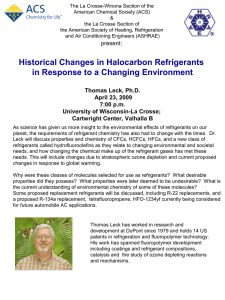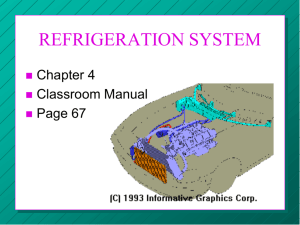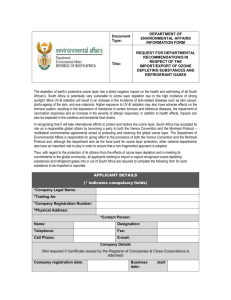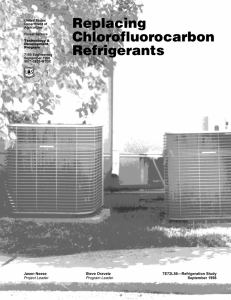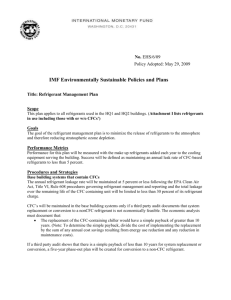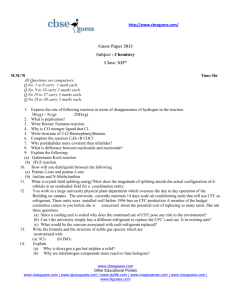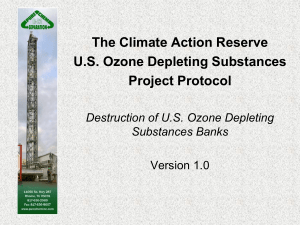Replacing Chlorofluorocarbon Refrigerants 1
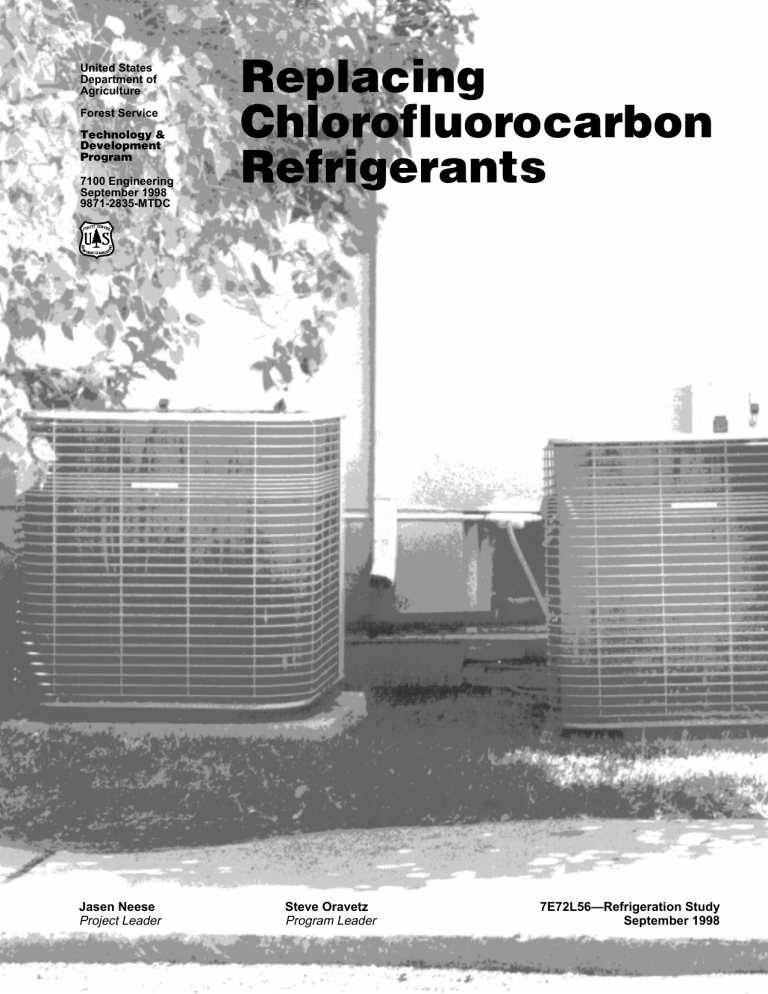
United States
Department of
Agriculture
Forest Service
Technology &
Development
Program
7100 Engineering
September 1998
9871-2835-MTDC
Replacing
Chlorofluorocarbon
Refrigerants
Jasen Neese
Project Leader
Steve Oravetz
Program Leader
7E72L56—Refrigeration Study
September 1998
1
Contents
Introduction _____________________________________ 3
Environmental Background ________________________ 3
Refrigerants Background __________________________ 4
The Current Situation _____________________________ 5
Procurement Laws _______________________________ 5
Environmental and Servicing Laws __________________ 6
The Significant New Alternatives Policy List __________ 6
Decisions Decisions Decisions _____________________ 7
Mobile Systems __________________________________ 8
Vehicle Options __________________________________ 8
Leave As Is ____________________________________________ 8
Repair and Recharge ____________________________________ 8
Retrofit to HFC-134a ____________________________________ 8
Retrofit to a Blend Refrigerant _____________________________ 8
Custom Vehicles _________________________________ 9
Appliances ______________________________________ 9
Small Appliances _______________________________________ 9
Larger Appliances ______________________________________ 9
Comfort Cooling Applications _____________________ 10
Window Units _________________________________________ 10
Central Air-Conditioning _________________________________ 10
Repair ______________________________________________ 10
Retrofitting ___________________________________________ 10
Replacement _________________________________________ 10
Chillers ______________________________________________ 10
About the Authors _______________________________ 11
Appendix A—Glossary ___________________________ 11
Appendix B—Contract Clauses ____________________ 12
Appendix C—Life-Cycle Cost Analyses _____________ 13
Appendix D—Sources of Additional Information ______ 16
The United States Department of Agriculture (USDA), prohibits discrimination in all its programs and activities on the basis of race, color, national origin, gender, religion, age, disability, political beliefs, sexual orientation, and marital or family status. (Not all prohibited bases apply to all programs.) Persons with disabilities who require alternative means for communication of program information (Braille, large print, audiotape, and so forth) should phone USDA’s TARGET Center at (202) 720-2600 (voice and TDD).
To file a complaint of discrimination, write: USDA, Director, Office of Civil Rights, Room 326-W, Whitten Building, 14th and Independence Avenue SW, Washington, DC 20250-9410, or call (202) 720-
5964 (voice or TDD). USDA is an equal opportunity provider and employer.
2
Introduction
The Forest Service has many applications that use chlorofluorocarbons (CFC’s) and hydrochlorofluorocarbons
(HCFC’s). This report provides guidance for updating these systems. These substances are thought to contribute to depletion of the earth’s protective ozone layer. As the Forest
Service repairs or replaces units using these refrigerants, it can choose alternatives that are more energy efficient and less harmful to the ozone layer. Because this topic uses specialized technical terms, a glossary has been included
(Appendix A).
d
Environmental Background
The Montreal Protocol Treaty set limits on the production and use of various ozone-depleting chemicals. Title VI of the Clean Air Act Amendments of 1990 addresses the
United States’ requirements for handling ozone-depleting substances and for phasing them out.
d
3
Refrigerants Background
CFC’s and HCFC’s (Figure 1) are chemicals typically used in refrigeration processes, air-conditioning, and other applications. The Clean Air Act classifies CFC’s as Class I ozone-depleting substances (the most harmful) and HCFC’s as Class II substances. The production of CFC’s essentially ended in 1996. Class II substances have phaseout dates scheduled in the future. Table 1 summarizes the common refrigerants used by the Forest Service and their phaseout dates.
Table 1—Ozone-depleting substances and their phaseout dates.
Refrigerant Phaseout Dates
Refrigerants scheduled for phaseout
Date of phaseout
Common
Forest Service uses
CFC-11
CFC-12
CFC-12
CFC-12
HCFC-123
HCFC-22
HCFC-22
HCFC-22
01/01/96
01/01/96
"
"
01/01/30
01/01/20
"
"
Chillers
Chillers
Automobiles
Small appliances
Chillers
Chillers
Window air-conditioners
Central air-conditioners
Figure 1—Cylinder of CFC-12, a widely used refrigerant.
d
4
The Current Situation
The tremendous demand for CFC’s with no new CFC’s being produced is creating a shortage. CFC-12, the most commonly used CFC, may become unavailable by the end of 1999. If that happens, all equipment needing to be recharged with CFC-12 would be unusable. A Service-wide phaseout of these chemicals can minimize the effects of the expected shortage on Forest Service operations.
d
Procurement Laws
In addition to environmental and market pressures to phase out the use of CFC’s, Federal agencies are required to minimize their use and procurement of ozone-depleting substances (Executive Order No. 12843 and Title 48 of the
Code of Federal Regulations, Chapter 1, Part 23, Subpart
23.8). In addition, contract clauses (Appendix B) must be inserted into solicitations or contracts for supplies that may contain ozone-depleting substances, including refrigerants.
d
5
Environmental and Servicing Laws
The Environmental Protection Agency (EPA) administers refrigerant regulations. The following rules of thumb summarize EPA regulations, but do not replace them. Appendix
D lists sources of additional information.
• Have leaking refrigerant systems fixed.
• Only EPA-certified technicians using EPA-certified recovery equipment can work on a refrigeration circuit.
• Under no circumstances, are you allowed to vent refrigerants into the atmosphere.
• Have the refrigerant removed before disposing of a unit containing refrigerant.
d
The Significant New
Alternatives Policy List
The Significant New Alternatives Policy (SNAP) program was created by the EPA to evaluate alternatives to ozonedepleting substances. Lists containing all acceptable and unacceptable refrigerants are available from the EPA. Table
2 contains a shortened list of acceptable replacement refrigerants. Many more applications and alternatives are listed in the updated SNAP catalog. Any refrigerant used as a replacement must be evaluated under the SNAP program. Check the SNAP lists if you want more information on replacement refrigerants.
Table 2—Forest Service applications and some common replacement alternative refrigerants.
*
Replacement Refrigerants for Ozone-Depleting Substances
Common Forest
Service uses
Ozone-depleting substance Alternatives Trade names
Manufacturers or distributors**
Chillers
Appliances
Freezers
Refrigerators
Reach-in coolers
Window air-conditioning
Central air-conditioning
Automobiles
R-11
R-12
R-12
R-12
R-12
R-12
R-22
R-22
R-22
R-12
R-12
HCFC-123
HFC-134a
HFC-134a
R-401B
Blends
R-401A
HCFC-22
HCFC-22
R-407C
HFC-134a
Blends
SUVA-123
Gentron 123
Forane 123
R-123
SUVA-134a
Gentron 134a
Forane 134a
KLEA 134a
R-134a
SUVA-134a
Gentron 134a
Forane 134a
KLEA 134a
R-134a
SUVA MP-66
Cool EZ RB-276
SUVA MP-39
R-22
R-22
SUVA 9000
SUVA-134a
Gentron 134a
Forane 134a
KLEA 134a
R-134a
FRIGC FR-12
Cool EZ RB-276
DuPont
Allied Signal
Elf Atochem others
DuPont
Allied Signal
Elf Atochem
ICI Americas others
DuPont
Allied Signal
Elf Atochem
ICI Americas others
DuPont
Quaker State
DuPont others others
DuPont
DuPont
Allied Signal
Elf Atochem
ICI Americas others
Pennzoil
Quaker State
* See SNAP list for more selections.
** Phone numbers available in Appendix D.
6
Decisions Decisions Decisions
You have three basic choices when deciding whether to repair or replace equipment containing refrigerants. The first option is to fix the equipment, recharging it with the original refrigerant, if it is available. Retrofitting should be considered if the original refrigerant has been phased out
(CFC-12). Many types of equipment can be retrofitted to use an alternative refrigerant. Retrofitted equipment typically has lower efficiency and less capacity than new equipment.
The third choice is to replace the unit. This option has the highest initial cost, but in many cases may be the cheapest over the lifetime of the equipment. Over the past 15 years, cooling equipment has become far more energy efficient.
Choosing between the options can be difficult. Economic and environmental factors play an important part in any decision. A life-cycle cost analysis can help you select an economically feasible option. The life-cycle cost analyses in Appendix C are most useful when the unit’s age or energyefficiency rating lies just above or below standards. Also, use a life-cycle cost analysis when the decision matrixes
(Figures 2, 3, and 4) do not present a clear-cut solution.
New equipment is more energy efficient and uses less harmful refrigerants. Managers should consider the risk of continuing to use equipment containing CFC’s into the next century. CFC’s may soon be unavailable. A CFC unit may become worthless if it loses its charge of refrigerant.
Appliance Replacement Decisions
Contains ozonedepleting substance
Older than
15 years Solution
Yes
Yes
Yes
Yes
No
No
No
No
1 See Appendix D.
Yes
No
Figure 3—Appliance decisions.
Replace with Energy Star
1
or equivalent.
If original refrigerant is not available, replace or retrofit with SNAP refrigerant.
If original refrigerant is available, fix and recharge.
Replace with Energy Star
1
or equivalent.
Fix and recharge.
Motor Vehicle Air-Conditioning
Unit contains
CFC-12
CFC-12 costs less than
$50-$75/lb.
Air-cond.
system under warranty Solution
Yes
Yes
Yes
No No
Yes
No
No Yes
Figure 2—Vehicle air-conditioning decisions.
Repair and recharge.
Retrofit to HFC-134a, change to a blend, or sell vehicle.
Retrofit to HFC-134a.
Repair and recharge.
Comfort Cooling Decisions
Contains ozoneOlder
Contains
50 lbs.
depleting than or more substance 10 years refrigerant
1
Is a water chiller Solution
Yes
Yes
Yes
Yes
Yes
No
No
No
No
Yes
No
Yes
No
Yes
Yes
Yes
Yes
No
No
No
No
Yes
No
Yes
No
No
No
No
Refer to Coolsense
2 network.
Life cycle cost analysis
3
.
Refer to Coolsense
2 network.
Life cycle cost analysis
3
.
Replace with Energy Star
2 or certified equivalent.
Life cycle cost analysis
3
.
Replace with Energy Star
2 or certified equivalent.
1 If Yes and the unit is leaking at a rate of 15% or more of the total charge, and over a 12-month period, the unit must be repaired within 30 days.
2 See Appendix D, Chillers.
3 See Appendix C.
Figure 4—Comfort cooling decisions.
d
7
Mobile Systems
CFC-12 was the dominant refrigerant in vehicle air-conditioning systems. In 1994 all vehicle manufacturers switched to HFC-134a, a refrigerant that does not deplete the ozone layer. A label under the vehicle’s hood indicates the type of refrigerant it contains (Figure 5). The Forest Service continually replaces its vehicles. Most vehicles still using
CFC-12 will be eliminated from the fleet as they are replaced.
For remaining vehicles many different options are available.
Figure 2 contains a decision matrix. The EPA’s SNAP list identifies replacement refrigerants and sources. Managers should look over the SNAP list before making any decision.
Vehicle Options
Leave As Is
Leaving a vehicle without air-conditioning may be a viable option. Consider the climate and the vehicle’s type of duty.
Repair and Recharge
This is probably the best option while CFC-12 is still available at a reasonable price. Many shops are equipped to handle the procedure. The cost of a simple recharge with
CFC-12 was about $100 to $200 in 1998. However, if the air-conditioning system needs to be recharged again, CFC-
12 may be unavailable or exceedingly expensive.
Figure 5—A label indicating that the air-conditioning system has been retrofitted to work with HFC-134a.
d
Retrofit to HFC-134a
Retrofitting to HFC-134a is the preferred alternative if CFC-
12 is unavailable or prohibitively expensive. A basic retrofit typically involves changing the high and low side port fittings, the label, the accumulator or drier, and the refrigerant. This should cost no more than $250, in addition to any repairs that must be made to the system. Retrofitted units may experience a small loss in cooling efficiency. Some vehicles may require replacement of other components to maintain satisfactory cooling. With a retrofit to HFC-134a, the airanywhere vehicle air-conditioning systems are fixed.
Retrofit to a Blend Refrigerant
A few manufacturers have produced blend refrigerants, mixtures of two or more refrigerants. Some of these blends are made for replacing CFC-12 in vehicle air-conditioning systems. Cooling efficiency is not as greatly affected with a blend as with HFC-134a. Table 2 contains some recommended blends. The service requirements of blends are generally simpler and cheaper than retrofitting to HFC-134a, typically requiring removing the old refrigerant, changing the high and low side port fittings, and replacing the label.
On the downside, blend refrigerants are not widely available.
In addition, retrofitting to any refrigerant other than HFC-
134a may void a warranty. Check with the manufacturer before performing a retrofit using blends. All blends contain ozone-depleting chemicals.
d
8
Custom Vehicles
Some stations may have custom-built vehicles that use refrigerants, such as vehicles used to transport seedlings or for food storage. Custom air-conditioning and refrigeration systems are more prone to leakage than manufactured units.
The options for replacing systems containing CFC’s are similar to those for retrofitting. However, most refrigerated cargo transports use HCFC-22 refrigerant. For refrigeration systems using HCFC refrigerants, repair and recharge is the simplest way to go.
d
Appliances
Small Appliances
Small appliances are defined as units hermetically sealed in the factory with a refrigerant charge of 5 pounds or less.
In small appliances such as refrigerators, freezers, and reach-in coolers, CFC-12 was the primary refrigerant used before its phaseout. Because the refrigeration circuits are hermetically sealed, these appliances rarely leak. Dramatic improvements in efficiency over the past 15 years can help managers decide whether to replace small appliances. Units
15 years or older that need a refrigeration circuit repair should be replaced instead. Figure 3 contains a decision matrix for appliances.
Larger Appliances
Larger appliances, such as walk-in coolers, typically use
HCFC-22. This refrigerant is not scheduled for phaseout until 2020. No satisfactory replacement has been accepted.
These appliances should be repaired and recharged.
d
9
Comfort Cooling Applications
Comfort cooling applications represent the highest use of refrigerants by the Forest Service. Because the Forest
Service typically has small buildings, the cooling systems are usually based on large residential or small-to-medium commercial units. For the past 35 years, HCFC-22 has been the used in these applications. This refrigerant is scheduled for phaseout in 2020.
Window Units
The majority of window units or room air-conditioners use
HCFC-22 (Figure 6), although some units using a HFC refrigerant have appeared on the market. The average life-time of these units averages around 10 to 15 years.
When one of these units breaks, it is usually more cost effective to replace the unit than to repair it. A highly efficient room air-conditioner can pay for itself in just a few years from the energy savings.
Repair
Repairing units using CFC’s requires careful consideration of the current shortage of CFC’s, the refrigerant’s environmental effects, and Federal laws. If a facility has a CFCbased system, a retrofit to a SNAP-acceptable refrigerant should be considered in any analysis. Deciding whether to repair models containing HCFC-22 should be based on the age of the unit. Generally, a unit 10 years old or older should be replaced by a newer, more efficient model that can pay for itself with energy savings in just a few years.
Look for models with a SEER (Seasonal Energy Efficiency
Ratio) rating of at least 12. Some units with ratings as high as 16.9 are available now. Ratings 10 years ago were 6 or 8.
Retrofitting
Only units using a CFC should be considered for retrofitting.
No replacement for HCFC-22 has been accepted industrywide. Repair or replacement is the recommended strategy until a replacement is identified.
Figure 6—Typical window unit used to supplement a central comfort cooling system.
Replacement
Replacing a central air-conditioning system increases a facility’s value. Once the decision is made to replace an older model, special consideration should be made in choosing a system that is the right size for the building’s load and climate. A correctly sized unit provides many benefits, including employee comfort and energy savings. A certified contractor can provide recommendations. Be sure to obtain recommendations from at least two or more contractors.
Appendix D provides guides that can help managers choose a replacement system.
Central Air-Conditioning
Central air-conditioning units come in all shapes and sizes.
The lifetime of central air-conditioning units is similar to that of window units, about 10 to 15 years. Most central units use HCFC-22. A label should be on any unit containing a refrigerant. Figure 4 is a decision matrix for choosing to repair or replace a central air-conditioning system.
Chillers
Large office buildings are typically cooled by chillers. Older chillers used CFC-12, CFC-11, or R-500 (a blend) as a refrigerant. Chiller repairs should be completed by an airconditioning expert. Information is available on CFC phaseout in chillers. Appendix D includes contacts for further information on chiller replacement, retrofitting, economics, and efficiency.
d
10
About the Authors
Jasen Neese
is a Mechanical Engineering Technician at MTDC. He is currently pursuing a bachelor’s degree in natural resource conservation at the University of
Montana.
Steve Oravetz
graduated from the University of Washington in Civil Engineering and is a licensed Professional
Civil Engineer. He began his career on the Wenatchee
National Forest in 1980. He became Chief Engineer for the
Northeastern Research Station in 1993. In 1996, he became
Engineering Program Leader at MTDC.
d
Appendix A—
Glossary
Chiller: The central part of a “chilled-water air-conditioning” system. Water is cooled in the chiller and moved throughout the building to different blower units.
Chlorofluorocarbon (CFC): A compound consisting of chlorine, fluorine, and carbon. CFC’s are commonly used as refrigerants, solvents, and foam-blowing agents. They are broken down by strong ultraviolet light in the stratosphere and release chlorine atoms that deplete the ozone layer.
Class I Substance: One of several groups of chemicals with an ozone-depletion potential of 0.2 or higher. The ozone-depletion potential of CFC-11 is defined to be
1.0. Any compound listed in the Clean Air Act, Title VI,
Section 602a, and all CFC’s, are Class I substances.
Class II Substance: A chemical with an ozone-depletion potential less than 0.2. The ozone-depletion potential of
CFC-11 is defined to be 1.0. The ozone-depletion potential of other substances is determined by comparing them to CFC-11. Any compound listed in the Clean Air
Act, Title VI, Section 602b. Currently, all HCFC’s are
Class II substances.
Clean Air Act (CAA): Law amended by Congress in 1990.
Title VI directs the Environmental Protection Agency to protect the ozone layer through several regulatory and voluntary programs. Sections within Title VI cover production of ozone-depleting substances, the recycling and handling of those substances, the evaluation of substitutes, and efforts to educate the public.
Demand Factor: The utility company monitors commercial customers for their peak power demand over the billing period. This demand peak corresponds to a pricing schedule. The higher the peak, the higher the price.
This price is then applied to the entire power usage within the billing period. The actual price changes from period to period, depending on the level of demand.
Some utilities also charge more if the customer’s peak is during a time of high demand.
Energy Efficiency Ratio (EER). A simple ratio of cooling output versus electrical power input.
Global Warming Potential (GWP): The ratio of the warming caused by a substance to the warming caused by a similar mass of carbon dioxide. The global warming potential of CO
2
is defined to be 1.0.
11
Appendix A—Glossary
Hydrochlorofluorocarbon (HCFC): A compound consisting of hydrogen, chlorine, fluorine, and carbon. HCFC’s are a class of chemicals used to replace CFC’s. Because of their chlorine atom, HCFC’s also deplete the ozone layer. They will be phased out.
Hydrofluorocarbon (HFC): A compound consisting of hydrogen, fluorine, and carbon. The HFC’s are a class of replacements for CFC’s. HFC’s do not deplete the ozone layer, but some HFC’s have the potential to contribute to global warmng.
kWh/Year: Estimated kilowatt hours consumed per year based on average use of the appliance.
Ozone: A gas composed of three atoms of oxygen. Nearly
90% of the Earth’s ozone is in the stratosphere where it is referred to as the ozone layer. Ozone absorbs a band of ultraviolet radiation called UVB that is harmful to living organisms.
Ozone-Depleting Potential: A number between 0.01 and 1 that refers to a substance’s relative potential for ozone depletion. The ozone-depletion potential of CFC-11 is defined to be 1.0.
Ozone-Depleting Substance (ODS): A compound that contributes to stratospheric ozone depletion. Ozonedepleting substances are generally very stable in the troposphere (the atmospheric region below the stratosphere) and only degrade under intense ultraviolet light in the stratosphere. When they break down, they release chlorine or bromine atoms, which deplete the ozone layer.
Ozone Depletion: Chemical destruction of the stratospheric ozone layer that exceeds natural levels.
Refrigerants: Liquids or gases with a very low boiling point that are used to absorb and transfer heat. Refrigerants are classified by a numbering system using R followed by a number. For instance, CFC-12 corresponds to R-12,
HCFC-22 corresponds to R-22, and HFC-134a corresponds to R-134a.
Seasonal Energy Efficiency Ratio (SEER). The higher the rating, the higher the energy efficiency. This ratio is similar to the Energy Efficiency Ratio, except that a full cooling season is used when evaluating the unit’s seasonal energy efficiency.
d
Appendix B— Contract Clauses
Title 48 of the Code of Federal Regulations,
Chapter 1, Part 52, Subpart 52.223-11
Ozone-Depleting Substances.
As prescribed in
23.804(a), insert the following clause:
Ozone-Depleting Substances (June 1996)
(a) Definition. “Ozone-depleting substance,” as used in this clause, means any substance designated as Class
I by the Environmental Protection Agency (EPA) (40
CFR Part 82), including but not limited to hydrochlorofluorocarbons, halons, carbon tetrachloride, and methyl chloroform; or any substance designated as Class II by
EPA (40 CFR Part 82), including but not limited to hydrochlorofluorocarbons.
(b) The Contractor shall label products which contain or are manufactured with ozone-depleting substances in the manner and to the extent required by 42 U.S.C.
7671j (b), (c), and (d) and 40 CFR Part 82, Subpart E, as follows:
WARNING: Contains (or manufactured with, if applicable)
*_________, a substance(s) which harm(s) public health and environment by destroying ozone in the upper atmosphere.
*The Contractor shall insert the name of the substance(s).
Title 48 of the Code of Federal REgulations,
Chapter 1, Part 52, Subpart 52.223-12
Refrigeration Equipment and Air Conditioners.
As prescribed in 23.804(b), insert the following clause:
Refrigeration Equipment And Air Conditioners (MAY 1995)
The Contractor shall comply with the applicable requirements of Sections 608 and 609 of the Clean Air
Act (42 U.S.C. 7671g and 7671h) as each or both apply to this contract.
d
12
Appendix C— Life-Cycle Cost Analyses
The following are general guides for life-cycle cost analyses involving refrigerant applications. They focus on life-cycle energy cost. Other costs such as maintenance and repair can be factored into the life-cycle cost equation. See the Federal
Energy Management Program’s reports, Buying Energy Efficient Products and Energy Price Indices and Discount Factors for Life-Cycle Cost Analysis, April 1998, for further reference.
Step One—Estimated Annual Energy Costs
Compute the annual energy cost for the application. Energy use for air-conditioners is figured differently than for appliances.
Air-Conditioning Energy Cost Formula—Estimated annual energy cost equals:
Cooling capacity of unit in Btuh 1
SEER number 1
X Cooling load hours
1000
2 X Electrical rate
1
3
Appliance Energy Cost Formula—Estimated annual energy costs equals: kWh/year 1 X electrical rate 3
Step Two—Estimated Lifetime Energy Costs
Once the annual energy cost has been computed, the lifetime cost is determined by multiplying the annual energy cost by the uniform present value multiplier (UPV) for your census zone (Figure 1).
Air-Conditioning—Uniform present value multiplier for a 15-year life cycle.
Zone 1 (Northeast)
9.68
Zone 2 (Midwest)
10.42
Zone 3 (South)
10.31
Zone 4 (West)
9.93
Appliances—Uniform present value multiplier for a 20-year life cycle.
Zone 1 (Northeast)
11.61
Zone 2 (Midwest)
12.48
Zone 3 (South)
12.37
Zone 4 (West)
11.9
NOTES :
1
These ratings are in the owner’s manual or can be obtained from the manufacturer or dealer.
2
See Figure 2 for a general estimate of your cooling load hours. Contact your power utility or a contractor for more precise estimates.
3
Most Forest Service facilities operate on a commercial demand rate, meaning the actual price of a kWh (kilowatt hour) fluctuates from month to month. The manager should use the historic average price over the cooling months when conducting a cooling analysis.
13
Appendix C—Life-Cycle Cost Analyses
Example
This example shows how to determine life-cycle costs when choosing whether to repair or replace a 7 SEER air-conditioner with a more efficient 14 SEER air-conditioner. Both units have a cooling capacity of 36,000 Btuh. The facility is in Missoula,
MT, which typically needs 500 hours (Figure 2) of cooling per year. The 15-year uniform present value multiplier for Zone 4
(the West) is 9.93.
Step One—Estimated Annual Energy Costs
Repair: 36000/7 X 500/1000 X 0.057
= $146.58 per year
Replacement: 36000/14 X 500/1000 X 0.057
= $73.29 per year
The 14 SEER unit saves $65.96 per year. The savings would be even greater if the electrical rate was higher.
Step Two—Estimated Lifetime Energy Costs
Repair: $146.58
X 9.93
= $1455.54
Replacement: $73.29
X 9.93
= $727.77
Over the typical 15-year life of an air-conditioning unit, the 14 SEER unit would save $727.77 in energy costs alone.
Washington
Montana
Oregon
Idaho
Wyoming
West Zone 4
Nevada
Utah
California
Colorado
Arizona
New Mexico
Alaska
West Zone 4
Hawaii
North Dakota
Northeast
Zone 1
New Hampshire
Maine
Minnesota
Wisconsin South Dakota
Michigan
Nebraska
Midwest
Iowa
Zone 2
Illinois
Indiana
Ohio
New Y ork Mass.
Conn.
Rhode
Island
Pennsylvania
New Jersey
Maryland
Kansas
West
Virginia
Virginia
Oklahoma
Kentucky
North Carolina
Tennessee
Arkansas
South Zone 3
Alabama
Georgia
Mississippi
South
Carolina
Texas
Missouri
Louisiana
Florida
Delaware
Figure 1—Zones used to determine the uniform present values.
14
Appendix C—Life-Cycle Cost Analyses
200
400
500
OR
WA
CA
AK
NV
1600
1800
ID
400
Missoula
MT
500
2000
AZ
Alaska. . . . . 0
Hawaii. . 2300
UT
600
WY
NM
CO
Cooling Load-Hour Map
ND
SD
400
600
MN
WI
IA
NE 800
IL
KS
1000
OK
1200
1400
TX
1600
1800
2000
2200
2400
2600
MI
AR
LA
MS
IN
MI
NY
ME
400
VT
NH
MA
RI
CN
OH
WV
PA
MD
VA
NJ
DE
TN
KY
NC
SC
GA
AL
2400
FL
2800
HI
Figure 2—Cooling load-hour estimates for life-cycle cost analysis.
d
15
Appendix D— Sources of Additional Information
Alternative Refrigerants (SNAP)
• EPA Fact Sheets
Phone: 888-STAR-YES (782-7937)
Internet: http://www.epa.gov/ozone/title6/snap/
• SNAP List of Approved Alternative Refrigerants
Phone: 888-STAR-YES (782-7937)
Internet: http://www.epa.gov/ozone/title6/snap/lists/ reflist.pdf (requires a copy of Adobe Acrobat Reader)
• The Navy’s descriptive document describing various alternative refrigerants
Internet: http://home.navisoft.com/navyozone/altref.htm
• Life-Cycle Cost Information
FEMP’s Energy Price Indices and Discount Factors for
Life-Cycle Cost Analysis, April 1998.
Available from the Energy Efficiency and Renewable
Energy Clearing House
Phone: 800-363-3732
Internet: http://www.eren.doe.gov/femp/techassist/ softwaretools/ashb98.wpd (878k WordPerfect document).
Chillers
• Coolsense is a program for chiller upgrades run by the
EPA, DOE, and GSA.
Internet: http://eande.lbl.gov/cbs/ateam/coolsense/ coolsense.html
• The Navy’s environmental informational clearinghouse includes topics ranging from ozone depletion to hazardous materials.
Internet: http://www.navyseic.com
• The U.S. Army Construction Engineering Research Laboratories has information on chiller refits and improving air-conditioning efficiency.
Phone: (217) 352-6511
Internet: http://www.cecer.army.mil
• The American Council for an Energy-Efficient Economy has information on increased energy efficiency.
Phone: (202) 429-0063
Internet: http://www.aceee.org/
• Government fact sheets on steps to increase energy efficiency at a facility are available.
Phone: 800-363-3732
Internet: http://www.eren.doe.gov/erec/factsheets/
• Energy Star Program
Government information on increasing energy efficiency and environmental impacts of a facility.
Phone: 888-STAR-YES (782-7937)
Internet: http://www.energystar.gov
Appliances
• Energy Star Program
Phone: 888-STAR-YES (782-7937)
Internet: http://www.energystar.gov/products/ appliances.html
• Federal Trade Commission document on appliances
Internet: http://www.ftc.gov/bcp/conline/pubs/homes/ applnces.htm
• The Maytag Company
Internet: http://www.maytag.com/index.asp
• Energy Efficiency and Renewable Energy Network (EREN) run by the U.S. Department of Energy
Phone: 800-363-3732
Internet: http://www.eren.doe.gov/buildings/ consumer_information/index.html
Comfort Cooling Applications
• Helpful information for choosing the right air-conditioner.
The Trane Company
Internet: http://www.trane.com/
• Apogee Consulting
Internet: http://www.apogee.net/res/recinfo.htm
• Environment Protection Agency’s information on cooling and heating systems
Phone: 888-STAR-YES (782-7937)
Internet: http://www.epa.gov/hvac.html
16
• Department of Energy
Internet: http://www.eren.doe.gov/buildings/ consumer_information/index.html
• Home Energy magazine’s article on selecting the correct size of air-conditioner, Bigger is Not Better When It Comes to Air-Conditioned Comfort.
Internet: http://www.homeenergy.org/ac-consumer.html
Appendix D—Sources of Additional Information
• Stage 5 Heating & Cooling System Upgrades-Part 5 of the Energy Star Buildings Upgrade Manual by the EPA’s
Office of Air and Radiation. Describes steps to increase building energy efficiency and options for heating and cooling systems.
Phone: 800-STAR-YES
Internet: www.epa.gov/appdstar/buildings/manual/ stage5.html
Environmental Protection Agency
Regulations
40 CFR 82 contains the core of EPA regulations regarding ozone-depleting substances
• The Navy’s Shore Facilities Ozone Depleting
Substances Conversion Guide For Heating, Ventilation, Air
Conditioning/ Refrigeration and Fire Protection Systems contains a nice summary of EPA regulations.
Internet: http://www.ncts.navy.mil/homepages/navfac_es
/shoreg2.html
• The EPA’s ozone depletion program has fact sheets avail-able over the Internet at:
Phone: 800-296-1996
Internet: http://www.epa.gov/ozone
Procurement Regulations
Executive Order No. 12843
Clear Air Act Amendments Section 613
40 CFR 82.84 Subpart D
48 CFR 23.8
48 CFR 52.223-11 and 52.223-12
42 USC 7671 through 7671(k)
Internet: http://www.access.gpo.gov/nara/cfr/index.html
General Guides
• ABC-123 A quick and concise lesson on heating and cooling systems.
Internet: http://ecep1.usl.edu/ecep/hvac/a/a.htm
• Consumer Guide to Efficient Central Climate Control
Systems
Describes the mechanics of air-conditioning and heating units, and contains tips for saving energy.
Internet: http://www.advantageair.com/about.shtml#leave
• Shore Facilities Ozone Depleting Substances Conversion
Guide For Heating, Ventilation, Air Conditioning/Refrigeration and Fire Protection Systems
The Navy’s plan to eliminate CFC from its operations
Internet: http://www.ncts.navy.mil/homepages/ navfac_es/shoreg2.htm
Professional Organizations
• The Air Conditioning Contractors of America-ACCA
Internet: http://www.acca.org
• Air-Conditioning and Refrigeration Institute-ARI
Internet: http://www.ari.org/
• American Society of Heating, Refrigerating and Air-
Conditioning Engineers (ASHRAE International)
Internet: http://www.ashrae.org/
• Refrigeration Service Engineers Society (RSES)
Internet: http://www.rses.org/
• Plumbing-Heating-Cooling Contractors National
Association (PHCC)
Internet: http://www.naphcc.org
17
Appendix D—Sources of Additional Information
Refrigerant Manufacturers and
Distributors
• DuPont
Internet: www.dupont.com
Phone: 800-235-SUVA (235-7882)
• Allied Signa
Internet: www.genetron.com/index2.html
Phone: 800-631-8138
• Elf Atochem
Internet: www.elf-atochem.com/newelf/fluoro98/
Phone: 800-245-5858
• ICI Americas
Internet: www.dircon.co.uk/klea/
Phone: 800-ICI-KLEA (424-5532)
• Quaker State
Internet: www.rgidirect.com
Phone: 888-FREE ZONE (373-3066)
• Pennzoil
Internet: www.frigc.com/
Phone: 800-424-3907 d
Library Card
Neese, Jasen; Oravetz, Steve. 1998. Replacing chlorofluorocarbon refrigerants. Tech. Rep. 9871-2835-MTDC.
Missoula, MT: U.S. Department of Agriculture, Forest
Service, Missoula Technology and Development Center.
18 electronic p.
Explains how to determine whether it is more economical to repair or replace cooling units that rely on chlorofluorocarbon refrigerants. These refrigerants are being phased out because they deplete the Earth’s protective ozone layer.
The report includes a glossary of refrigerant terms, contract clauses that should be included for refrigeration equipment and air-conditioners, an example of life-cycle cost analysis, and a list including sources of additional information.
Keywords: air conditioning, CFC, cooling, cost analysis,
Freon, HCFC, ozone depletion
Additional single copies of this document may be ordered from:
USDA Forest Service, MTDC
Building 1, Fort Missoula
Missoula, MT 59804-7294
Phone: (406) 329-3900
Fax: (406) 329-3719
IBM: pubs/wo,mtdc
E-mail: pubs/wo_mtdc@fs.fed.us
An electronic copy of this document is available on the Forest Service’s FSWeb intranet at:
http://fsweb.mtdc.wo.fs.fed.us
For further technical information, contact Steve
Oravetz at the address above.
Phone: (406) 329-1037
Fax: (406) 329-3719
IBM: soravetz/wo,mtdc
E-mail: soravetz/wo_mtdc@fs.fed.us
— End of Document —
18
